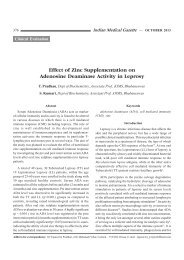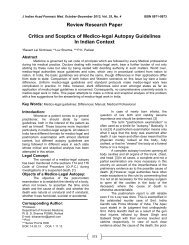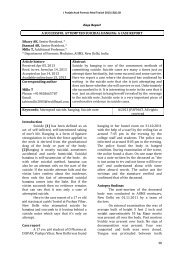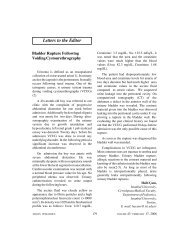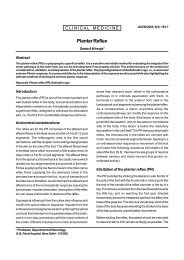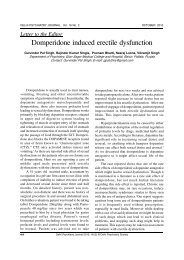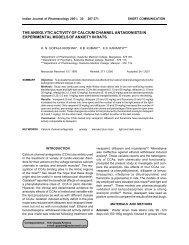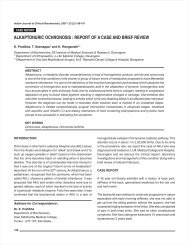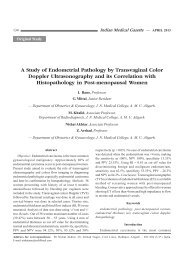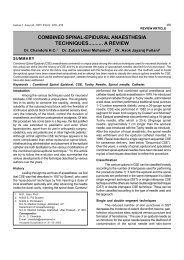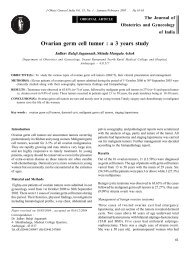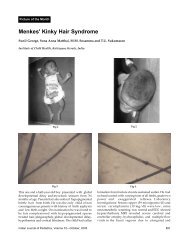InPouch TV culture for detection of Trichomonas vaginalis - medIND
InPouch TV culture for detection of Trichomonas vaginalis - medIND
InPouch TV culture for detection of Trichomonas vaginalis - medIND
Create successful ePaper yourself
Turn your PDF publications into a flip-book with our unique Google optimized e-Paper software.
Indian J Med Res 125, April 2007, pp 567-571<br />
<strong>InPouch</strong> <strong>TV</strong> TM <strong>culture</strong> <strong>for</strong> <strong>detection</strong> <strong>of</strong> <strong>Trichomonas</strong> <strong>vaginalis</strong><br />
Seema Sood, Srujana Mohanty, Arti Kapil, Jorge Tolosa + & Suneeta Mittal*<br />
Departments <strong>of</strong> Microbiology, *Obstetrics & Gynaecology, All India Institute <strong>of</strong> Medical Sciences,<br />
New Delhi, India & + Global Network <strong>for</strong> Perinatal & Reproductive Health, Thomas Jefferson University,<br />
Philadelphia, PA, USA<br />
Received March 29, 2006<br />
Background & objectives: <strong>Trichomonas</strong> <strong>vaginalis</strong> accounts <strong>for</strong> almost half <strong>of</strong> all curable sexually<br />
transmitted infections and has also been associated with adverse outcomes <strong>of</strong> pregnancy and<br />
increased risk <strong>of</strong> HIV in women. Diagnosis <strong>of</strong> the condition by direct wet mount examination has<br />
a low sensitivity. Herein, we describe our experience with <strong>InPouch</strong> <strong>culture</strong> system <strong>for</strong> the <strong>detection</strong><br />
<strong>of</strong> T. <strong>vaginalis</strong>.<br />
Methods: This prospective study was carried out from May 2003 to April 2004 among women<br />
presenting with genitourinary symptoms attending a primary health center clinic in Ballabhgarh,<br />
India. Two vaginal swabs (cotton tips) were obtained from each woman. The first swab was obtained<br />
from the lateral wall <strong>of</strong> vagina and was used to make a wet mount preparation. The second swab<br />
was obtained from the posterior <strong>for</strong>nix <strong>of</strong> the vagina and inoculated in the <strong>InPouch</strong> <strong>for</strong> <strong>culture</strong> <strong>of</strong><br />
T. <strong>vaginalis</strong>.<br />
Results: Of the 601 women, 22 were positive by direct microscopy <strong>for</strong> T. <strong>vaginalis</strong> while 40 were<br />
positive by <strong>culture</strong>. Overall, T. <strong>vaginalis</strong> accounted <strong>for</strong> 6.7 per cent <strong>of</strong> reproductive tract infections.<br />
Interpretation & conclusion: The <strong>InPouch</strong> <strong>TV</strong> <strong>culture</strong> system is a simple, cost-effective and a sensitive<br />
method <strong>for</strong> diagnosing T. <strong>vaginalis</strong> and may be recommended <strong>for</strong> routine use in diagnosing genital<br />
tract infections.<br />
Key words <strong>InPouch</strong> <strong>culture</strong> - reproductive tract infections - sexually transmitted infections - <strong>Trichomonas</strong> <strong>vaginalis</strong><br />
567
568<br />
INDIAN J MED RES, APRIL 2007<br />
<strong>Trichomonas</strong> <strong>vaginalis</strong>, a sexually transmitted<br />
flagellated protozoan, afflicts an estimated 180 million<br />
women per year worldwide 1 . The World Health<br />
Organization (WHO) has estimated that this infection<br />
accounts <strong>for</strong> almost half <strong>of</strong> all curable sexually<br />
transmitted infections 2 . Clinical syndrome in females<br />
vary from asymptomatic presentations to (more<br />
commonly) vaginitis with copious discharge. Infection<br />
can be associated with serious sequelae such as preterm<br />
labour, premature rupture <strong>of</strong> membranes and low birth<br />
weight as well as increased risk <strong>of</strong> transmission <strong>of</strong> other<br />
sexually transmitted diseases (STDs), including human<br />
immunodeficiency virus (HIV) 3,4 .<br />
Associations <strong>of</strong> trichomoniasis in women with<br />
adverse outcomes <strong>of</strong> pregnancy and increased risk <strong>of</strong><br />
HIV suggest a need <strong>for</strong> increased control ef<strong>for</strong>ts, and<br />
accurate diagnosis is necessary <strong>for</strong> specific treatment<br />
and control <strong>of</strong> this disease. Diagnosis <strong>of</strong> trichomoniasis<br />
in women is usually accomplished via direct microscopic<br />
examination <strong>of</strong> the vaginal fluid by wet mount<br />
preparation; however, the sensitivity <strong>of</strong> this test is low<br />
(overall 60%) and may be lower in asymptomatic<br />
women. Culture is clearly the most sensitive diagnostic<br />
method and various <strong>culture</strong> media have been described<br />
<strong>for</strong> cultivation <strong>of</strong> T. <strong>vaginalis</strong>. Though polymerase chain<br />
reaction (PCR) techniques have been found more<br />
sensitive than <strong>culture</strong>, different studies have shown its<br />
specificity to be slightly lower than <strong>culture</strong> 5,6 .<br />
In this study, we describe our experience with the<br />
<strong>InPouch</strong> <strong>culture</strong> system (Biomed Diagnostics, San<br />
Jose, Cali<strong>for</strong>nia) <strong>for</strong> the <strong>detection</strong> <strong>of</strong> T. <strong>vaginalis</strong>. This<br />
is a commercially available system which combines a<br />
wet preparation and a <strong>culture</strong> method to detect T.<br />
<strong>vaginalis</strong>.<br />
Material & Methods<br />
We carried out a prospective study from May<br />
2003 to April 2004 among women presenting with<br />
genitourinary symptoms attending a primary health<br />
center clinic in Ballabhgarh, Haryana, in India. An<br />
attempt was made to detect T. <strong>vaginalis</strong> infection<br />
in symptomatic women. In<strong>for</strong>med consent was<br />
obtained from each participant woman.<br />
The inclusion criteria <strong>for</strong> the study were, married<br />
and sexually active women between 18 to 49 yr <strong>of</strong><br />
age with self-reported symptoms <strong>of</strong> vaginal discharge<br />
and/or genital itching and/or genital burning. Pregnant<br />
women, women with severe medical disorders<br />
requiring immediate referral to higher level <strong>of</strong> health<br />
care, women who were currently menstruating, never<br />
been sexually active, who had a hysterectomy, had<br />
taken a course <strong>of</strong> antibiotics within last three weeks<br />
and who had been previously enrolled in this study<br />
were excluded. This study was a part <strong>of</strong> a large<br />
collaboration study with USA.<br />
Two vaginal swabs (cotton tips) were obtained<br />
from each woman. The purpose was to get as much<br />
specimen as possible. The first swab was obtained<br />
from the lateral wall <strong>of</strong> vagina and was used to make<br />
a wet mount preparation on a glass slide with a drop<br />
<strong>of</strong> normal saline on the site <strong>of</strong> specimen collection.<br />
The slide was initially scanned at 100X, looking <strong>for</strong><br />
motile trichomonads, and then at 400X to confirm<br />
motility, flagellar movement and morphologic features<br />
<strong>of</strong> the organisms. Negative wet mounts were<br />
examined <strong>for</strong> at least two minutes.<br />
The second swab was obtained from the posterior<br />
<strong>for</strong>nix <strong>of</strong> the vagina and inoculated in the top pouch<br />
<strong>of</strong> <strong>InPouch</strong> (Biomed Diagnostics, USA) <strong>for</strong> <strong>culture</strong><br />
<strong>of</strong> T. <strong>vaginalis</strong>. <strong>InPouch</strong> <strong>TV</strong> is a double pouched<br />
container made <strong>of</strong> s<strong>of</strong>t plastic (Fig.). The specimen<br />
was introduced into the bottom pouch immediately<br />
after collection; microscopic examination <strong>of</strong> the<br />
bottom pouch was conducted when the specimen<br />
arrived in the laboratory (no examination was made<br />
<strong>of</strong> the top pouch because its contents had been<br />
immediately pushed into the bottom pouch).<br />
The <strong>culture</strong>s were incubated at 35 o C and<br />
examined <strong>for</strong> motile T. <strong>vaginalis</strong> at 24, 48 and 96 h
SOOD et al: INPOUCH <strong>TV</strong> CULTURE 569<br />
Top pouch<br />
Bottom<br />
pouch<br />
Opening <strong>for</strong> insertion <strong>of</strong> swab<br />
Fig. Diagram <strong>of</strong> <strong>InPouch</strong> <strong>TV</strong>.<br />
<strong>of</strong> incubation by using a 10X objective directly through<br />
the pouch. Internal quality control <strong>for</strong> T. <strong>vaginalis</strong><br />
<strong>InPouch</strong> <strong>culture</strong> was made by incubating one <strong>InPouch</strong><br />
per batch as a sterility check on reagents and<br />
inoculating one pouch with a known <strong>culture</strong> <strong>of</strong> T.<br />
<strong>vaginalis</strong> to check the quality <strong>of</strong> the batch <strong>of</strong> <strong>InPouch</strong>.<br />
Statistical analysis was done using the Mc-Nemar<br />
Chi Square test.<br />
Results & Discussion<br />
A total <strong>of</strong> 710 women were screened as they<br />
were willing to participate in the study, but only 611<br />
were eligible <strong>for</strong> enrolment. However, data could be<br />
collected and analyzed from 601 women as the rest<br />
declined internal examination. Of the 601 women, 22<br />
were positive by direct microscopy <strong>for</strong> T. <strong>vaginalis</strong><br />
while 40 were positive by <strong>culture</strong> which was found<br />
to be statistically significant (P < 0.001). All were<br />
<strong>culture</strong> positive within 48 h <strong>of</strong> incubation. Overall,<br />
T. <strong>vaginalis</strong> accounted <strong>for</strong> 6.7 per cent (40/601) <strong>of</strong><br />
reproductive tract infections.<br />
The time honoured approach <strong>for</strong> the diagnosis <strong>of</strong><br />
trichomonal infection has been microscopic evaluation<br />
by the wet mount method, a procedure first described<br />
by Donne’ in 1836 7 . This procedure, however, detects<br />
only 35 to 80 per cent <strong>of</strong> the cases, depending on<br />
the expertise <strong>of</strong> the microscopist 8,9 . It is already<br />
established that a minimal concentration <strong>of</strong> 10 4<br />
organisms per milliliter <strong>of</strong> vaginal fluid appears to be<br />
necessary <strong>for</strong> identification <strong>of</strong> the protozoa by wet<br />
mount 8 . The relatively low sensitivity <strong>of</strong> wet mount<br />
examination has been confirmed in this study too.<br />
Because <strong>of</strong> the limitations <strong>of</strong> the wet mount,<br />
<strong>culture</strong> remains the most accurate single method <strong>for</strong><br />
detecting the presence <strong>of</strong> T. <strong>vaginalis</strong> in patient<br />
samples 8-10 . Routinely, 95 per cent <strong>of</strong> cases are<br />
diagnosed by this method. Optimal growth and<br />
reproduction <strong>of</strong> T. <strong>vaginalis</strong> require anaerobic<br />
conditions and an unusually large number <strong>of</strong> essential<br />
nutrients, including carbohydrates, amino acids,<br />
purines, pyrimidines, fatty acids, vitamins and iron 11 .<br />
Although several commercial liquid media are<br />
available <strong>for</strong> this purpose, Diamond’s medium is<br />
considered the “gold standard”. The <strong>InPouch</strong> <strong>TV</strong><br />
<strong>culture</strong> system, the one we have used has been found<br />
to be as reliable as Diamond’s medium in detecting<br />
T. <strong>vaginalis</strong> 12 .<br />
We observed that the <strong>InPouch</strong> <strong>TV</strong> <strong>culture</strong><br />
detected 45 per cent more positives than the traditional<br />
wet mount. The sensitivity <strong>of</strong> wet mount preparation<br />
in our study was 55 per cent and falls very much<br />
within the range documented so far. The specificity<br />
<strong>of</strong> the wet mount preparation was 100 per cent. The<br />
presence <strong>of</strong> trichomonads was determined by its<br />
characteristic size, shape and mobility in both tests,<br />
the specificity was there<strong>for</strong>e considered the same <strong>for</strong><br />
both the wet mount and the <strong>InPouch</strong> <strong>TV</strong> method.
570<br />
INDIAN J MED RES, APRIL 2007<br />
Overall, T. <strong>vaginalis</strong> accounted <strong>for</strong> 6.7 per cent<br />
<strong>of</strong> reproductive tract infections in our study. Worldwide,<br />
researchers have reported a prevalence <strong>of</strong> 1.3<br />
to 16.5 per cent 13,14 <strong>of</strong> T. <strong>vaginalis</strong> in reproductive<br />
tract infections. The prevalence <strong>of</strong> T. <strong>vaginalis</strong> in<br />
India ranges from 0.8 to 14.0 per cent but most studies<br />
have relied on the wet preparation alone and there<br />
is no “gold standard” confirmation 15-17 . Although the<br />
combination <strong>of</strong> <strong>culture</strong> and wet mount examination<br />
remains the standard approach <strong>for</strong> detecting<br />
T. <strong>vaginalis</strong> in patient samples 12 , <strong>InPouch</strong> <strong>of</strong>fers some<br />
distinct advantages. Once the specimen is placed by<br />
a clinician into the <strong>InPouch</strong> chamber, microscopic<br />
observation can be made directly through the bag as<br />
the bag can be used as a slide on the stage <strong>of</strong> the<br />
microscope. This obviates the need <strong>for</strong> sampling to<br />
examine the <strong>culture</strong> <strong>for</strong> growth thereby preventing<br />
contamination. These can be conveniently transported<br />
from the site <strong>of</strong> collection to the laboratory and can<br />
be stored at room temperature. Other media, once<br />
prepared, require refrigeration. Further, its cost is<br />
comparable to the ordinary <strong>culture</strong> tube. There<strong>for</strong>e,<br />
the <strong>InPouch</strong> <strong>culture</strong> system may be used as a routine<br />
method <strong>of</strong> diagnosing trichomoniasis.<br />
Acknowledgment<br />
Authors acknowledge the Global Network <strong>for</strong> Perinatal and<br />
Reproductive Health (GNPRH), USA, <strong>for</strong> providing the pouches,<br />
and <strong>culture</strong>s were done as a part <strong>of</strong> a study funded by Population<br />
Council, New Delhi, India.<br />
References<br />
1. World Health Organization. Global prevalence and incidence<br />
<strong>of</strong> selected curable sexually transmitted infections, 2001.<br />
WHO/HIV-AIDS/2001-02/CDC/CSR/EDC/2001.10.<br />
2. Cates W and the American Social Health Association Panel.<br />
Estimates <strong>of</strong> the incidence and prevalence <strong>of</strong> sexually<br />
transmitted diseases in the United States. Sex Transm Dis<br />
1999; 26 : 52-7.<br />
3. Wolner-Hanssen P, Krieger JN, Stevens CE, Kiviat NB,<br />
Koutsky L, Critchlow C, et al. Clinical manifestations <strong>of</strong><br />
vaginal trichomoniasis. JAMA 1989; 261 : 571-6.<br />
4. Royce RA, Seva A, Cates W, Cohen MS. Sexual<br />
transmission <strong>of</strong> HIV. N Engl J Med 1997; 336 : 1072-8.<br />
5. Madico G, Quinn TC, Rampalo A, McKee KT Jr, Gaydos<br />
CA. Diagnosis <strong>of</strong> <strong>Trichomonas</strong> <strong>vaginalis</strong> infection by PCR<br />
using vaginal swab samples. J Clin Microbiol 1998; 36 :<br />
3205-10.<br />
6. Lawing L, Hedges S, Schwebke J. Detection <strong>of</strong><br />
trichomoniasis in vaginal and urine specimens from women<br />
by <strong>culture</strong> and PCR. J Clin Microbiol 2000; 38 : 3585-8.<br />
7. Donne’ A. Animacules observes dans les mantieres<br />
purulentes at al produit des secretions des organs genitaux<br />
de Thomme et de la femme. CR Acad Sci 1836; 3 : 285-6.<br />
8. Krieger JN, Tam MR, Stevens CE, Nielsen ID, Hale J,<br />
Kaviat NB, et al. Diagnosis <strong>of</strong> trichomoniasis: comparison<br />
<strong>of</strong> conventional wet-mount examination with cytologic<br />
studies, <strong>culture</strong>s, and monoclonal antibody staining <strong>of</strong> direct<br />
specimens. JAMA 1988; 259 : 1223-7.<br />
9. McMillan A. Laboratory diagnostic methods and<br />
cryopreservation <strong>of</strong> trichomonads. In: Honigsberg BM,<br />
editor. Trichomonads parasitic in humans. New York:<br />
Springer; 1989 p. 299-310.<br />
10. Spence MR, Hollander DH, Smith J, Mc Gaig L, Sewell<br />
P, Brockman M. The clinical and laboratory diagnosis <strong>of</strong><br />
<strong>Trichomonas</strong> <strong>vaginalis</strong> infection. Sex Transm Dis 1980;<br />
7 : 168-71.<br />
11. Linstead D. Cultivation. In: Honigsberg BM, editor.<br />
Trichomonads parasitic in humans. New York: Springer;<br />
1989 p. 91-111.<br />
12. Levi MH, Torres J, Pina C, Klein RS. Comparison <strong>of</strong> the<br />
<strong>InPouch</strong> <strong>TV</strong> <strong>culture</strong> system and Diamond’s modified<br />
medium <strong>for</strong> <strong>detection</strong> <strong>of</strong> <strong>Trichomonas</strong> <strong>vaginalis</strong>. J Clin<br />
Microbiol 1997; 35 : 3308-10.<br />
13. Anh PK, Khauh NT, Ha DT, Chien do T, Thue PT, Luong<br />
PH, et al. Prevalence <strong>of</strong> lower genital tract infection among<br />
women attending maternal and child health and family<br />
planning clinics in Hanoi, Vietnam. Southeast Asian J Trop<br />
Med Public Health 2003; 34 : 367-73.
SOOD et al: INPOUCH <strong>TV</strong> CULTURE 571<br />
14. Garcia PJ, Chavez S, Feringa B, Chiappe M, Li W, Jansen<br />
KW, et al. Reproductive tract infections in rural women<br />
from the highlands, jungle and coastal regions <strong>of</strong> Peru.<br />
Bull World Health Organ 2004; 82 : 483-92.<br />
15. AIDS Prevention and Control Project (APAC). 1998.<br />
Community prevalence <strong>of</strong> sexually transmitted diseases in<br />
Tamil Nadu 1998- A Report. AIDS Prevention and Control<br />
Project, Voluntary Health Services, Chennai, India.<br />
16. Kumar P, Sharma NK, Sharma U, Sharma RP, Idnani R,<br />
Agarwal AK. Trichomoniasis and candidiasis in cohorts <strong>of</strong><br />
females with vaginal discharge. Indian J Sex Transm Dis<br />
1990; 11 : 54-6.<br />
17. Bang RA, Bang AT, Baitule M, Choudhary Y,<br />
Sarmukaddam S, Tale O. High prevalence <strong>of</strong><br />
gynaecological diseases in rural Indian women. Lancet<br />
1989; 8629 : 85-7.<br />
Reprint requests: Dr Suneeta Mittal, Pr<strong>of</strong>essor & Head, Department <strong>of</strong> Obstetrics & Gynaecology<br />
Reprint requests: All India Institute <strong>of</strong> Medical Sciences, Ansari Nagar, New Delhi 110029, India<br />
Reprint requests: e-mail: suneeta_mittal@yahoo.com



